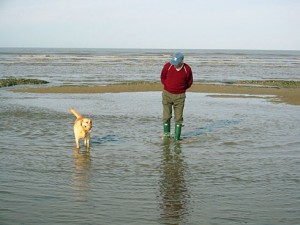Good boy

Via Science Now, the EPA has found that letting two dogs run around a beach improved the quality of the accompanying water. The environmental agency looked at a Lake Michigan beachfront in Racine, Wisconsin, where bacteria from shoreboards — specifically, their droppings — raised the water’s toxicity to dangerous levels.
First they tried “oiling” the bird’s eggs, which is exactly what you think it is — they find the seagull nests and coat the eggs with oil, which keeps them from hatching. (An aside: if you’re that close to the nest, why not just drop the eggs on the sidewalk? Too on-the-nose?).
That worked, but only so-so. The next thing they tried was a combination of “combing” the beach to turn over the bird droppings in the sand, and setting loose two border collies to unsettle the birds. That worked better. Writes Science Now‘s Naomi Lubick:
When the team analyzed its samples in the lab, measuring the concentrations of E. coli, Enterococcus, and other contaminants, it detected the presence of potentially pathogenic bacteria like Salmonella and Campylobacter (a species that includes C. jejuni, a common cause of gastroenteritis) for 7 of the 11 pre-dog sampling days. But during the 9 gull-free days, the team couldn’t detect the bacterial pathogens at all, and the levels of E. coli and Enterococcus species dropped dramatically and rapidly.
Being the EPA, they then spent awhile trying to figure out how to construct a sustainable bird-scaring system. Airports use shotguns to startle birds away from runways, but that’s not so pleasant at the beach. Instead, they’re thinking of sending the border collies and a human handler to patrol the beach regularly.
We humbly submit another idea: Let people take dogs to beaches.




